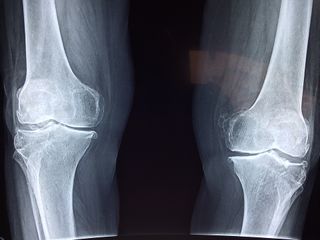Deep-Space Challenge: Broken Bones May Heal Best in Earthlike Gravity

The forces of gravity and physical exertion may be key to healing broken bones, new research suggests.
Successful long-duration space travel — such as orbiting Earth's moon long term or journeying to Mars and beyond — needs to include methods that both maintain and repair the bodies of human travelers if they suffer from deterioration or injury. The new study focuses on how cartilage — the tissue that appears in knees, hips and bone-fracture healing — fares in space.
"Cartilage engineering is such a critical field of interest, because cartilage, being an avascular tissue, without having a blood supply, does not have the ability to regenerate," University of Missouri researcher Elizabeth Loboa, co-author on the new work and dean of engineering at the University of Missouri, told Space.com. "Or, if say someone in space broke their bone … when those two bone ends reconnect again, there's a process in the intermediary phase before the bone is fully healed that you have new cartilage generation." [The Human Body in Space: 6 Weird Facts]
Scientists across many disciplines are developing technologies to make lengthy journeys possible. Some are involved in projects to grow food in microgravity, and others are building spacecraft to make the journeys.
Loboa, Liliana Mellor and Andrew Steward of the University of Missouri decided to look at how cartilage forms during the bone-healing process in microgravity conditions. Microgravity is a weightlessness that astronauts experience in space when moving in freefall, like on the International Space Station. For the human body to be healthy, it must be able to develop strength, maintain its musculoskeletal system, and repair any injuries. Cartilage cells, known as chondrocytes, are essential to joint maintenance, and cartilage stem cells are also generated by the body to reconnect broken bones, Loboa said. Astronauts on long-term space missions are subject to conditions, however, that are detrimental to cartilage health, such as microgravity.
When astronaut Scott Kelly completed his nearly yearlong stay on the space station, a research team found that his bone formation rate had decreased after the first six months of the space mission. In weightless conditions, Kelly and other space crew members exercise for about 2 hours a day to avoid muscle atrophy and loss of bone density. To stay healthy, their bodies need to simulate walking and daily activity under the force of gravity on Earth's surface. This is known as mechanical loading. Long exposure to microgravity, on the other hand, exposes the body to unhealthy levels of mechanical unloading, which is like what the body experiences during prolonged bed rest.
With long-duration missions on the horizon that could keep astronauts in microgravity for more than six months, space agency officials are making it their business to learn how to support the physical health of their long-duration crew by studying scenarios like Kelly's mission. [How Do You Work Out Without Gravity? Astronaut Workout | Video]
Get the Space.com Newsletter
Breaking space news, the latest updates on rocket launches, skywatching events and more!

To start their experiment, the University of Missouri research team placed adipose-derived stem cells — which come from fat tissue and help the body repair bones — into three environments to understand what mechanisms best help the cells to regenerate. One replicated microgravity, whereas one re-created mechanical loading.
"What we're trying to do is show the difference and the need for appropriate mechanical loading for tissue engineering of new cartilage," Loboa said.
The team exposed one set of cultured stem cells to a simulation of microgravity, by using a rotating wall vessel bioreactor designed by NASA Johnson Space Center scientists, and exposedanother set to simulated mechanical loading, byusing a rotating pressure vesselto reproduce the effect. They also left one in a static control, with Earth's normal gravitational pull.Inspecting how the stem cells fared, the team found that the simulated gravity's mechanical-loading effect enhanced the stem cells more than microgravity and the control. The extra pressure, like what cartilage experiences when the body is in motion, was crucial to cartilage cell growth.

"The mechanical stimulation produced by CHP [cyclic hydrostatic pressure], which mimics the mechanical environment that … cartilage experiences during daily activities here on Earth, enhanced cartilage formation when compared to cells cultured in microgravity bioreactors," the researchers wrote in the study.
It appears that the closer space crew members can get to experiencing Earth-like physical activity, the healthier their bones and joints will remain and repair.
This work was detailed in April 2017 in the journal Aerospace Medicine and Human Performance.
Follow Doris Elin Salazar on Twitter @salazar_elin. Follow us @Spacedotcom, Facebook and Google+. Original article on Space.com.
Join our Space Forums to keep talking space on the latest missions, night sky and more! And if you have a news tip, correction or comment, let us know at: community@space.com.

Doris is a science journalist and Space.com contributor. She received a B.A. in Sociology and Communications at Fordham University in New York City. Her first work was published in collaboration with London Mining Network, where her love of science writing was born. Her passion for astronomy started as a kid when she helped her sister build a model solar system in the Bronx. She got her first shot at astronomy writing as a Space.com editorial intern and continues to write about all things cosmic for the website. Doris has also written about microscopic plant life for Scientific American’s website and about whale calls for their print magazine. She has also written about ancient humans for Inverse, with stories ranging from how to recreate Pompeii’s cuisine to how to map the Polynesian expansion through genomics. She currently shares her home with two rabbits. Follow her on twitter at @salazar_elin.
